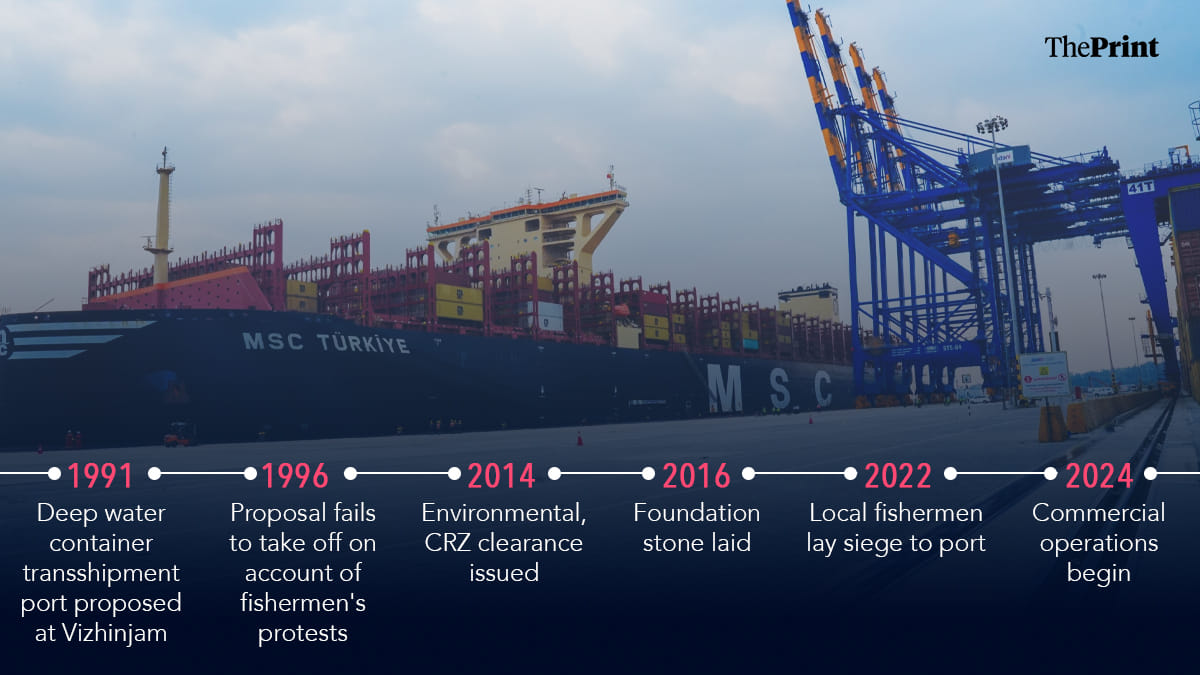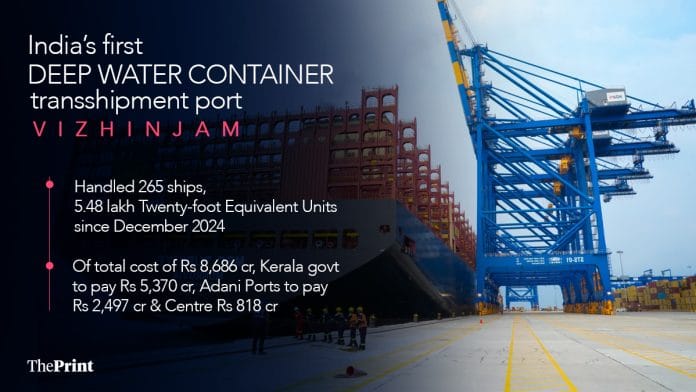Thiruvananthapuram: When the strategically located Vizhinjam International Seaport, India’s first deep water container transshipment port, is inaugurated by PM Narendra Modi, it will not only mark the beginning of a new chapter in the country’s book on maritime trade but, officials hope, also power Kerala’s development and draw Keralites back home from overseas.
The port, which is connected to almost all major continents, is expected to enhance the potential for more investments in and exports from the nation and Kerala, fuelling hopes it will reshape the state’s economic and infrastructural landscape and help Thiruvananthapuram shed its ‘pensioners’ town’ tag.
Located close to international shipping routes, the country’s first deep water container transshipment port—where cargo from various countries is consolidated and redistributed using mother and feeder vessels—commenced its commercial operations on 3 December, 2024. It will be officially commissioned by the Prime Minister Friday.
Since 3 December, it has already handled 265 ships and 5.48 lakh Twenty-foot Equivalent Units (TEU), including MSC Turkiye, considered one of the largest ships in the world.
“From 3 December, the gateway of India has shifted 1,600 km south to Trivandrum. India’s contribution to global merchandise exports is just 2 percent. The inefficiency is in our logistics system, whether it’s on our rail, air, or sea, Vizhinjam changes all of that,” an official at Vizhinjam International Seaport Limited (VISL) said on condition of anonymity.

Currently, most of India’s transshipment containers are handled by Sri Lanka’s Colombo port, and the inauguration of the Vizhinjam port is expected to bring that back to India, saving a significant amount of foreign exchange and revenue.
The official quoted earlier said the state government is actively working to improve the logistics and infrastructure around the port to maximise its benefits, the first being the Rs 1,600-crore underground rail project expected to be completed by 2028. To be built by the Konkan Railway Limited, the 10.7-km-long railway line includes the 9.43 km underground stretch connecting the port to the Balaramapuram railway station in Thiruvananthapuram.
“In the initial years, most of the container movement is expected from Tamil Nadu, Andhra Pradesh, Telangana and Karnataka. From there, the ideal transportation is through train,” the official told ThePrint.
Kerala government approved its Detailed Project Report (DPR) last month and the acquisition of land is underway, according to the office of the Minister for Ports V.N. Vasavan.
The state has also proposed an 80-km-long six-lane ring road in the district that starts at National Highway 66 from the district’s Navaikulam and reaches Vizhinjam. The corridor is also envisaged to have special economic development zones at Kallambalam, Kovalam, Vizhinjam, Kattakada, Nedumangad, Vembayam and Kilimanoor.
The land requirement for their development would be met through land pooling. Additionally, another 1.7-km road linking the port to NH-66 being built by the Adani Group is nearing completion, the official said. “If we create the right policies and create an ecosystem leveraging the Vizhinjam port, we can reverse migration. This port is not only a gateway for India, it opens up immense opportunities for the state of Kerala,” he said.
According to the Kerala Migration Survey (KMS) 2023, two out of every five households of the state had non-resident Keralites, and the number of international emigrants from the state was 21,54,275 in the year. Of that, 11.3 percent (or 2,50,000) were students. The survey noted the state received a total remittance of Rs 2,16,893 crore in 2018.
The port, however, finds itself in the middle of a credit war now, with political parties competing to take credit for its construction. Addressing a press conference Wednesday, CM Pinarayi Vijayan said the port became a reality due to the LDF government’s perseverance.
“It is the only port in the country that has the most investment from a state government,” he said, adding that the state government has spent 61.83 per cent of the total cost. Of the total Rs 8,686 crore, Rs 5,370 crore will be borne by the state, Rs 2,497 crore by the Adani Ports, and Rs 818 crore by the central government, he said.
Vijayan criticised the BJP-led central government, saying it omitted the state government’s contribution while advertising the port. Titled ‘Ports Powering Viksit Bharat 2047’, the Ministry of Ports, Shipping and Waterways issued an ad in English-language newspapers Wednesday. The ad that talked about the Vizhinjam port and the inauguration didn’t feature the name or picture of the Kerala’s chief minister though it featured the image of PM Modi.
The state’s primary opposition party, the Congress, has also come forward claiming credit for the project. The Leader of the Opposition in Kerala V.D. Satheesan said Wednesday the project was approved in 2015 by then Congress chief minister Oommen Chandy. The Congress has also put up posters near the port thanking Chandy for doing his part.
Vizhinjam port’s journey
A port in Vizhinjam was a long-pending project in the state, conceived as early as 1991.
Initial works, including a tender, was started by the Congress government under K. Karunakaran. Later, the LDF’s E.K. Nayanar government too moved ahead with it, but it failed to take off due to multiple reasons, including protests by local fishermen.
The project saw a revival in 2014 under the Congress government. Being built under a Public Private Partnership (PPP) mode with Adani Ports Private Limited, the foundation stone for the port was laid in 2015 by then chief minister Oommen Chandy.
The full construction is expected to be completed in three phases. The first has now been completed and commissioned with an investment of Rs 8,000 crore. According to initial agreement, the project was expected to be operational by 2019, however the Okhi cyclone in 2017 and then the COVID-19 outbreak delayed it.
India’s first deep water port—natural depth enables a port to accommodate even the world’s largest ships without extensive dredging—is located three km from Kovalam and nearly 20 km from Thiruvananthapuram airport.
With 30 berths, the port is just 10 nautical miles from the busy international shipping route connecting Europe, the Persian Gulf, and the Far East, its website says.
Presenting the state budget this year, Finance Minister K.N. Balagopal said the entire project will be completed in phases by 2028 with Adani Group investing Rs 9,500 crore. Apart from this, the Union government is providing Viability Gap Funding (VGF) of Rs 817.80 crore to the project.
“Once Adani hands over the port, they will have spent nearly Rs 30,000 crore in the state. We are also expecting much more as a trickle-down effect,” the official said.
During the Global Investment Summit held in Kochi in February this year, the Adani Group had announced an interest in investing Rs 30,000 crore in the state’s infrastructure, logistics over the next five years.
However, the project has witnessed massive opposition from the local fishing community since 2015, expressing concerns over possible livelihood losses and sea erosion. The protest turned violent in July 2022 with local fishermen laying siege to the port from land and sea, demanding a proper environmental impact assessment study.
The protest went for over 100 days, with police registering cases against many for rioting and conspiracy. The protest ended in December 2022, after the state agreed to provide a rent of Rs 5,500, subsidies for fuel for boats to the affected fishermen. In March 2024, the government withdrew cases against protestors, a month before the Lok Sabha elections.
Vijayan said the state heard the locals’ concerns. Rs 114.30 crore has been spent for the rehabilitation of the locals, he said, adding that a training centre has been built with an investment of Rs 50 crore to ensure locals are skilled and employed at the port.
(Edited by Ajeet Tiwari)
Also read: Kerala budget brings hikes in taxes & levies amid fiscal deficit crisis






